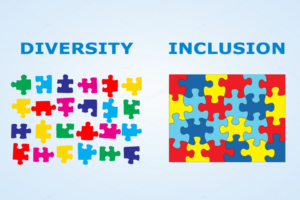Introduction:
In today’s interconnected world, Canada has witnessed an unprecedented rise in immigration, leading to a diverse patient population. This increased diversity highlights the importance of cultural competence in healthcare provision. Embracing cultural competence enables nurses to provide enhanced patient care while understanding the unique needs of individuals from diverse cultural backgrounds. In this blog post, we will explore the significance of diversity and inclusion in nursing and healthcare, dive into the concept of cultural competence, and discuss strategies for fostering an inclusive healthcare environment.
Understanding Diversity and Inclusion: 
Diversity and inclusion are not mere buzzwords but fundamental pillars of nursing practice. Diverse healthcare teams bring a range of perspectives and experiences, resulting in improved patient care, effective communication, and higher patient satisfaction. Embracing diversity and creating inclusive environments allow nurses to foster a sense of belonging for the diverse patient populations they serve.
Cultural Competence: 
Cultural competence refers to the ability to recognize, understand, and respect cultural differences. To deliver exceptional and unbiased patient care, healthcare providers must familiarize themselves with the cultures and practices prevalent among Canada’s diverse patient population. Recognizing personal biases and assumptions is essential for cultivating cultural competence.
Recognizing and Respecting Cultural Differences: 
Nurses who acknowledge and respect cultural differences build trusting relationships with their patients. Cultural disparities significantly impact interactions between patients and healthcare providers. Understanding and respecting diverse cultures and practices enable nurses to deliver sensitive, tailored care that meets individual patient needs, ultimately leading to greater patient satisfaction. It is crucial to be mindful of language barriers, beliefs, values, traditions, healthcare practices, and communication styles to establish therapeutic relationships with patients.
Improving Cross-Cultural Communication: 
Effective cross-cultural communication plays a pivotal role in nursing practice. Healthcare providers can leverage resources and tools to familiarize themselves with different communication styles across cultures. Active listening, appropriate utilization of interpreters, and culturally sensitive communication techniques facilitate improved cross-cultural communication, ensuring accurate information exchange.
Developing Cultural Competence in Healthcare Settings: 
Developing cultural competence requires a collaborative effort between healthcare providers and organizations. Nurses can actively nurture cultural competence through various strategies, such as participating in diversity and cultural competency training programs. Engaging in self-directed learning, seeking mentorship from experienced colleagues, and immersing oneself in diverse communities further augment cultural understanding and competence. Healthcare organizations can promote an inclusive environment through initiatives like diverse hiring practices, cultural competence training, and establishing safe spaces for open dialogue.
Leadership and healthcare organizations play a crucial role in cultivating an inclusive and diverse healthcare environment. Initiatives such as diverse hiring practices, cultural competence training, and the creation of safe spaces for open dialogue can foster diversity and inclusion. An inclusive environment supports professional growth for healthcare providers, facilitates comprehensive patient care, and drives positive organizational change.
Conclusion:
Promoting diversity and inclusion in nursing through cultural competence is vital for delivering patient-centered care. By embracing cultural differences and respecting individual needs, nurses can improve patient outcomes, enhance communication, and address health disparities. Embracing diversity and fostering an inclusive nursing environment not only benefits patients but also contributes to a thriving healthcare system that appreciates the richness of our diverse society. Let us continue our journey toward cultural competence, champion diversity and inclusion in nursing, and make a meaningful impact on patient care and the nursing profession as a whole.


